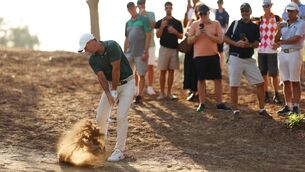The row that raged over Garvey’s stand
Not surprisingly, the issue is central to an interesting book I received over the festive period titled “Philomena Garvey: Queen of the Irish Fairways” written by Paul Garvey, the proprietor and manager of the Irish Golf Archives website, and unrelated to the famous golfer. Sadly, Ms Garvey passed away on May 5 last but she remains the greatest female golfer ever produced by this country, a claim substantiated by her wide array of achievements over a 30-year period from the end of World War Two until well into the 1970s.
Henry Cotton, the prince of English golfers for several decades, described her as “the finest woman golfer I’ve ever seen” and aspects of her game were compared to Ben Hogan and Walter Hagen. Philomena captured the Irish Close Championship on 15 occasions, the British Amateur Championship and made six appearances on the Curtis Cup team.
However, it was that victory in the British Amateur at Gleneagles in 1957 in which she beat the great Jessie Valentine of Scotland in the final that led to the cause celebre that became her refusal to take her place in the biannual contest against the Americans the following year. She was an automatic choice on the GB & I team but the storm clouds began to gather when the British-based LGU decided to change the emblem from the international emblem of the rose, thistle, shamrock and leek previously worn to the Union Jack.
At a press conference on June 28, 1958, Garvey confirmed her intentions by stating: “It would have been disloyal to my country were I to accept and wear such an emblem.” In her letter to the LGU, she pointed out that “I do not mean any slight or offence to Great Britain.”
On receiving Phil’s letter, LGU President Molloy Gourlay reacted: “The council has considered this and decided there is no reason to change their decision.”
The controversy raged throughout the summer of 1958 with Garvey at all times trying to limit the publicity it attracted as much as possible.
Some time later, she explained her stance: “The LGU are entitled to make any decision they wish about what shall be worn but I am an Irish woman and we have a flag here of our own. It would look strange if I wore a flag that was not the flag of my own country.”
Philomena Garvey had nothing whatever against the GB & I players and turned up at the match to show her support. Even then, she could do nothing right in the eyes of some British people. Paul Garvey’s book details how Henry Longhurst, the celebrated and hugely respected golf correspondent of The Sunday Times for many years and who had been a long-time admirer, gave her both barrels.
“Among the spectators, unaccountably to many of us, was Miss Philomena Garvey of Eire … of all the places one did not expect to see her was among the colleagues whose company she had rejected. The ways of women are strange indeed.”
Others, however, had a broader view of the situation. As it so happened, the President of the ILGU and also captain of the Curtis Cup team was a Northern Ireland lady, Daisy Ferguson. She had massive respect for Philomena Garvey both as a golfer and person and issued a statement that demonstrated commendable understanding of her position.
“I consider the choice of the LGU of the Union Jack as the badge for the British Isles team has made it difficult, if not impossible, for any golfer from Eire to play for the LGU British Isles team now or at any other future date,” she said. “The greatest sympathy and understanding will be felt for Miss Garvey in the impossible situation in which she has been placed.”
Ferguson offered her resignation as Curtis Cup captain in writing to the LGU. They didn’t accept it and she went on to lead the side to a tie – the best result ever achieved on American soil up to that time.
Accordingly, they retained the trophy, having won it two years previously when, ironically enough, Philomena Garvey played her part in a rare GB & I triumph.
















